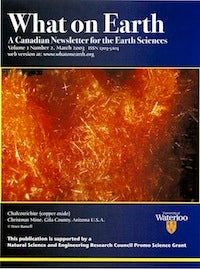News
Filter by:
Copper specimens from the Royal Ontario Museum
(Above) Wire copper on calcite, Tsumeb, Namibia © Peter Russell
(Below) Copper, White Pine Mine, Michigan. Donated to the Royal Ontario Museum by the Women's Association of the Mining Industry of Canada Foundation.
Rise and fall of the Great Lakes - part II
A couple of years ago in Wat on Earth (Fall, 1999) short-term variations in Great Lakes water levels, mainly resulting from meteorological effects, were described with passing reference to the effect of crustal tilting, which is a slow, long-term process.
Copper - the red metal
Peter Russell and Kelly Snyder

Native copper vein in shale, White Pine Mine, Michigan
Junior miner of Ontario competition
Inspire Your Students to Bring Earth Science to Life!
Earth materials are used in every facet of our lives. A walk through city streets provides an opportunity to observe various stones used in buildings, roads and pavements. Our homes, transportation systems and machinery contain metals derived from ore deposits. From computers to toothpaste, minerals are used in such a variety of products. We need only to observe objects used in everyday life to discover the unique and essential role Earth Science plays in today's rapidly changing world.
Sedimentary rocks
Alan V. Morgan
Geoscape Canada
Pascale Côté, Bob Turner, John Clague
The Isle of Eigg and Hugh Miller
Peter I. Russell
Everyone has special mileposts in their lives where interests take off. My interest in field geology received a burst of energy after reading "The Cruise of the Betsy," a book by 19th century geologist, Hugh Miller.
The world's largest trilobite; the Waterloo Connection!
Alan V. Morgan
Students and members of the public visiting the Earth Sciences museum (soon to be relocated in the new atrium in the Centre for Environmental Information Technology in Fall, 2003) have the opportunity of looking at casts of two very large trilobites. One of these has been in the museum since 1989, the second was purchased far more recently in 2002, and both originated from Churchill, Manitoba. So how is there a connection with Waterloo?
